Backpack Process Model (BPPM): A Process Mining Approach for Curricular Analytics
Abstract
Featured Application
Abstract
1. Introduction
2. The Backpack Metaphor
3. Related Work in Process Mining
4. The Backpack Process Model (BPPM) Approach
4.1. Data Extraction
- -
- s indicates the ID of the student who took the course
- -
- p the academic period when the course was taken
- -
- c the identifier of the course taken
- -
- g the final grade obtained
- -
- d the end date of the academic period.
4.2. Event Log Generation
4.3. Discovery
4.4. Analysis
5. Application Case: First Engineering Courses
- (P1)
- BPPM trajectories ending either in retention or in dropout
- (P2)
- most frequent backpacks.
- (P3)
- size of the backpack.
6. Discussion
7. Conclusions
Author Contributions
Funding
Institutional Review Board Statement
Informed Consent Statement
Data Availability Statement
Conflicts of Interest
References
- Viberg, O.; Hatakka, M.; Bälter, O.; Mavroudi, A. The current landscape of learning analytics in higher education. Comput. Hum. Behav. 2018, 89, 98–110. [Google Scholar] [CrossRef]
- Banihashem, S.K.; Aliabadi, K.; Ardakani, S.P.; Delaver, A.; Ahmadabadi, M.N.; Ardakani, S.P.; Delavar, A. Learning Analytics: A Systematic Literature Review. Interdiscip. J. Virtual Learn. Med. Sci. 2018, 9. [Google Scholar] [CrossRef]
- Gottipati, S.; Shankararaman, V. Competency analytics tool: Analyzing curriculum using course competencies. Educ. Inf. Technol. 2018, 23, 41–60. [Google Scholar] [CrossRef]
- Hilliger, I.; De Laet, T.; Henríquez, V.; Guerra, J.; Ortiz-Rojas, M.; Zuñiga, M.Á.; Baier, J.; Pérez-Sanagustín, M. For Learners, with Learners: Identifying Indicators for an Academic Advising Dashboard for Students. In Proceedings of the European Conference on Technology Enhanced Learning. EC-TEL 2020: Addressing Global Challenges and Quality Education, Heidelberg, Germany, 14–18 September 2020; Lecture Notes in Computer Science. Alario-Hoyos, C., Rodríguez-Triana, M.J., Scheffel, M., Arnedillo-Sánchez, I., Dennerlein, S.M., Eds.; Springer: Cham, Switzerland, 2020; Volume 12315, pp. 117–130. [Google Scholar] [CrossRef]
- Ochoa, X. Simple Metrics for Curricular Analytics. In Proceedings of the 1st Learning Analytics for Curriculum and Program Quality Improvement Workshop, Sixth International Learning Analytics and Knowledge Conference (LAK), 25–29 April 2016; Available online: http://ceur-ws.org/Vol-1590/paper-04.pdf (accessed on 25 March 2021).
- Levander, L.M.; Mikkola, M. Core Curriculum Analysis: A Tool for Educational Design. J. Agric. Educ. Ext. 2009, 15, 275–286. [Google Scholar] [CrossRef]
- Simanca, F.; Crespo, R.G.; Rodríguez-Baena, L.; Burgos, D. Identifying Students at Risk of Failing a Subject by Using Learning Analytics for Subsequent Customised Tutoring. Appl. Sci. 2019, 9, 448. [Google Scholar] [CrossRef]
- Mabel, Z.; Britton, T.A. Leaving late: Understanding the extent and predictors of college late departure. Soc. Sci. Res. 2018, 69, 34–51. [Google Scholar] [CrossRef]
- Rawatlal, R. Application of Graph Theory to Analysing Student Success Through Development of Progression Maps. In Engineering Education for a Smart Society. GEDC 2016, WEEF 2016. Advances in Intelligent Systems and Computing; Auer, M.E., Kim, K.-S., Eds.; Springer: Cham, Switzerland, 2018; Volume 627, pp. 295–307. [Google Scholar] [CrossRef]
- Campbell, C.M.; Mislevy, J.L. Student Perceptions Matter: Early Signs of Undergraduate Student Retention/Attrition. J. Coll. Stud. Retention: Res. Theory Pr. 2013, 14, 467–493. [Google Scholar] [CrossRef]
- Mason, C.; Twomey, J.; Wright, D.; Whitman, L. Predicting Engineering Student Attrition Risk Using a Probabilistic Neural Network and Comparing Results with a Backpropagation Neural Network and Logistic Regression. Res. High. Educ. 2018, 59, 382–400. [Google Scholar] [CrossRef]
- Zúniga-Prieto, M.A.; Ortiz, M.; Ulloa, M.; Jiménez, A. Applying the LALA Framework for the adoption of a Learning Analytics tool in Latin America: Two case studies in Ecuador. In Proceedings of the Third Latin American Conference on Learning Analytics, Cuenca, Ecuador, 1–2 October 2020. In press. [Google Scholar]
- Moreno-Marcos, P.M.; Muñoz-Merino, P.J.; Maldonado-Mahauad, J.; Pérez-Sanagustín, M.; Alario-Hoyos, C.; Kloos, C.D. Temporal analysis for dropout prediction using self-regulated learning strategies in self-paced MOOCs. Comput. Educ. 2020, 145, 103728. [Google Scholar] [CrossRef]
- Jivet, I.; Scheffel, M.; Specht, M.; Drachsler, H. License to evaluate: Preparing learning analytics dashboards for educational practice. In Proceedings of the 8th International Conference on Learning Analytics and Knowledge, Sydney, NSW, Australia, 5–9 March 2018. [Google Scholar] [CrossRef]
- Cairns, A.H.; Gueni, B.; Fhima, M.; Cairns, A.; David, S.; Khelifa, N. Process Mining in the Education Domain. Int. J. Adv. Intell. Syst. 2015, 8, 219–232. Available online: http://www.iariajournals.org/intelligent_systems/tocv8n12.html (accessed on 25 March 2021).
- Bogarín, A.; Cerezo, R.; Romero, C. A survey on educational process mining. Wiley Interdiscip. Rev. Data Min. Knowl. Discov. 2017, 8, e1230. [Google Scholar] [CrossRef]
- Salazar-Fernández, J.P.; Sepúlveda, M.; Munoz-Gama, J. Describing Educational Trajectories of Engineering Students in Individual High-Failure Rate Courses that Lead to Late Dropout. In Proceedings of the Second Latin American Conference on Learning Analytics, Valdivia, Chile, 18–19 March 2019; Available online: http://ceur-ws.org/Vol-2425/paper03.pdf (accessed on 25 March 2021).
- Munoz-Gama, J.; Maldonado-Mahauad, J.; Salazar-Fernández, J.P.; Bustamante, D.; Sepúlveda, M. Backpack Process Model (BPPM): Curricular Analytics through Process Mining. In Proceedings of the III Conferencia Latinoamericana de Analíticas de Aprendizaje, Cuenca, Ecuador, 1–2 October 2020. In press. [Google Scholar]
- Snyder, K.E.; Barr, S.M.; Honken, N.B.; Pittard, C.M.; Ralston, P.A.S. Navigating the First Semester: An Exploration of Short-Term Changes in Motivational Beliefs Among Engineering Undergraduates. J. Eng. Educ. 2018, 107, 11–29. [Google Scholar] [CrossRef]
- Choi, Y. Student Employment and Persistence: Evidence of Effect Heterogeneity of Student Employment on College Dropout. Res. High. Educ. 2018, 59, 88–107. [Google Scholar] [CrossRef]
- Geisinger, B.N.; Raman, D.R. Why They Leave: Understanding Student Attrition from Engineering Majors? Int. J. Eng. Educ. 2013, 29, 914–925. Available online: https://lib.dr.iastate.edu/abe_eng_pubs/607 (accessed on 25 March 2021).
- Kuley, E.A.; Maw, S.; Fonstad, T. Engineering Student Retention and Attrition Literature Review. In Proceedings of the Canadian Engineering Education Association, Hamilton, ON, Canada, 31 May–3 June 2015; Available online: https://ojs.library.queensu.ca/index.php/PCEEA/article/view/5813/pdf (accessed on 25 March 2021).
- Bandura, A. Self-Efficacy: The Exercise of Control; W.H. Freeman: New York, NY, USA, 1997. [Google Scholar]
- Meyer, M.; Marx, S. Engineering Dropouts: A Qualitative Examination of Why Undergraduates Leave Engineering. J. Eng. Educ. 2014, 103, 525–548. [Google Scholar] [CrossRef]
- Roldán-Riejos, A.M.; Úbeda-Mansilla, P. Metaphor use in a specific genre of engineering discourse. Eur. J. Eng. Educ. 2006, 31, 531–541. [Google Scholar] [CrossRef]
- Lopes, L.L. Between Hope and Fear: The Psychology of Risk. In Advances in Experimental Social Psychology; Berkowitz, L., Ed.; Academic Press: Cambridge, MA, USA, 1987; Volume 20, pp. 255–295. [Google Scholar] [CrossRef]
- Arnold, K.E.; Pistilli, M.D. Course signals at Purdue: Using learning analytics to increase student success. In LAK ’12: Proceedings of the 2nd International Conference on Learning Analytics and Knowledge; ACM: New York, NY, USA, 2012; pp. 267–270. [Google Scholar] [CrossRef]
- van der Aalst, W. Process Mining: The Missing Link. In Process Mining: Data Science in Action; van der Aalst, W., Ed.; Springer: Berlin/Heidelberg, Germany, 2016. [Google Scholar] [CrossRef]
- Martin, N.; De Weerdt, J.; Fernández-Llatas, C.; Gal, A.; Gatta, R.; Ibáñez, G.; Johnson, O.; Mannhardt, F.; Marco-Ruiz, L.; Mertens, S. Recommendations for enhancing the usability and understandability of process mining in healthcare. Artif. Intell. Med. 2020, 109, 101962. [Google Scholar] [CrossRef]
- Utama, N.I.; Sutrisnowati, R.A.; Kamal, I.M.; Bae, H.; Park, Y.-J. Mining Shift Work Operation from Event Logs. Appl. Sci. 2020, 10, 7202. [Google Scholar] [CrossRef]
- Van Der Aalst, W.M. A practitioner’s guide to process mining: Limitations of the directly-follows graph. Procedia Comput. Sci. 2019, 164, 321–328. [Google Scholar] [CrossRef]
- Bin Ahmadon, M.A.; Yamaguchi, S. Verification Method for Accumulative Event Relation of Message Passing Behavior with Process Tree for IoT Systems. Information 2020, 11, 232. [Google Scholar] [CrossRef]
- van Eck, M.L.; Lu, X.; Leemans, S.J.J.; van der Aalst, W.M.P. PM^2: A Process Mining Project Methodology. In Advanced Information Systems Engineering; Zdravkovic, J., Kirikova, M., Johannesson, P., Eds.; Springer: Cham, Switzerland, 2015; pp. 297–313. [Google Scholar] [CrossRef]
- Dumas, M.; la Rosa, M.; Mendling, J.; Reijers, H.A. Introduction to Business Process Management. In Fundamentals of Business Process Management; Springer: Berlin/Heidelberg, Germany, 2013. [Google Scholar] [CrossRef]
- Maldonado-Mahauad, J.; Pérez-Sanagustín, M.; Kizilcec, R.F.; Morales, N.; Munoz-Gama, J. Mining theory-based patterns from Big data: Identifying self-regulated learning strategies in Massive Open Online Courses. Comput. Hum. Behav. 2018, 80, 179–196. [Google Scholar] [CrossRef]
- Johnson, O.A.; Dhafari, T.B.; Kurniati, A.; Fox, F.; Rojas, E. The ClearPath Method for Care Pathway Process Mining and Simulation. In Business Process Management Workshops; Springer International Publishing: Cham, Switzerland, 2019; Volume 342, pp. 239–250. [Google Scholar] [CrossRef]
- Lorenz, R.; Senoner, J.; Sihn, W.; Netland, T. Using process mining to improve productivity in make-to-stock manufacturing. Int. J. Prod. Res. 2021, 1–12. [Google Scholar] [CrossRef]
- Reimann, P.; Markauskaite, L.; Bannert, M. e-Research and learning theory: What do sequence and process mining methods contribute? Br. J. Educ. Technol. 2014, 45, 528–540. [Google Scholar] [CrossRef]
- Zhou, X.; Zacharewicz, G.; Chen, D.; Chu, D. A Method for Building Service Process Value Model Based on Process Mining. Appl. Sci. 2020, 10, 7311. [Google Scholar] [CrossRef]
- Salazar-Fernandez, J.P.; Sepúlveda, M.; Munoz-Gama, J. Influence of student diversity on educational trajectories in engineering high-failure rate courses that lead to late dropout. In Proceedings of the 2019 IEEE Global Engineering Education Conference (EDUCON), Dubai, United Arab Emirates, 9–11 April 2019; pp. 607–616. [Google Scholar] [CrossRef]
- Berti, A.; van Zelst, S.J.; van der Aalst, W. Process mining for python (PM4Py): Bridging the gap between process-and data science. arXiv 2019, arXiv:1905.06169. [Google Scholar]
- Janssenswillen, G.; Depaire, B.; Swennen, M.; Jans, M.; Vanhoof, K. bupaR: Enabling reproducible business process analysis. Knowl. Based Syst. 2019, 163, 927–930. [Google Scholar] [CrossRef]
- Günther, C.W.; Rozinat, A. Disco: Discover Your Processes; BPM (Demos): Tallin, Estonia, 2012; Volume 940, pp. 40–44. Available online: http://ceur-ws.org/Vol-940/paper8.pdf (accessed on 25 March 2021).
- Geyer-Klingeberg, J.; Nakladal, J.; Baldauf, F.; Veit, F. Process Mining and Robotic Process Automation: A Perfect Match. In Proceedings of the International Conference on Business Process Management, Sydney, Australia, 9–14 September 2018; pp. 1–8, 124–131. Available online: http://ceur-ws.org/Vol-2196/BPM_2018_paper_28.pdf (accessed on 25 March 2021).
- Kember, D.; Leung, D.; Prosser, M. Has the open door become a revolving door? The impact on attrition of moving from elite to mass higher education. Stud. High. Educ. 2021, 46, 258–269. [Google Scholar] [CrossRef]
- Rodríguez-Gómez, D.; Meneses, J.; Gairín, J.; Feixas, M.; Muñoz, J.L. They have gone, and now what? Understanding re-enrolment patterns in the Catalan public higher education system. High. Educ. Res. Dev. 2016, 35, 815–828. [Google Scholar] [CrossRef]
- Stump, G.S.; Husman, J.; Corby, M. Engineering Students’ Intelligence Beliefs and Learning. J. Eng. Educ. 2014, 103, 369–387. [Google Scholar] [CrossRef]
- Suresh, R. The Relationship between Barrier Courses and Persistence in Engineering. J. Coll. Stud. Retent. Res. Theory Pr. 2006, 8, 215–239. [Google Scholar] [CrossRef]
- Haag, S.; Collofello, J. Engineering undergraduate persistence and contributing factors. In Proceedings of the 38th Annual Frontiers in Education Conference, Saratoga Springs, NY, USA, 22–25 October 2008; pp. T4D-8–T4D-14. [Google Scholar] [CrossRef]
- Bernasconi, A. Inclusion Programs at Elite Universities: The Case of Chile. In Mitigating Inequality: Higher Education Research, Policy, and Practice in an Era of Massification and Stratification; Advances in Education in Diverse Communities; Emerald Publishing Limited: Bingley, UK, 2015; Volume 11, pp. 303–310. [Google Scholar] [CrossRef]
- Bose, R.J.C.; Mans, R.S.; Van Der Aalst, W.M. Wanna improve process mining results? In Proceedings of the 2013 IEEE Symposium on Computational Intelligence and Data Mining (CIDM), Singapore, 16–19 April 2013; IEEE: New York, NY, USA, 2013; pp. 127–134. [Google Scholar] [CrossRef]
- Salazar-Fernandez, J.; Sepúlveda, M.; Munoz-Gama, J.; Nussbaum, M. Curricular Analytics to Characterize Educational Trajectories in High-Failure Rate Courses That Lead to Late Dropout. Appl. Sci. 2021, 11, 1436. [Google Scholar] [CrossRef]
- Sage, A.J.; Cervato, C.; Genschel, U.; Ogilvie, C.A. Combining Academics and Social Engagement: A Major-Specific Early Alert Method to Counter Student Attrition in Science, Technology, Engineering, and Mathematics. J. Coll. Stud. Retent. Res. Theory Pract. 2021, 22, 611–626. [Google Scholar] [CrossRef]
- Tariq, Z.; Khan, N.; Charles, D.; McClean, S.; McChesney, I.; Taylor, P. Understanding Contrail Business Processes through Hierarchical Clustering: A Multi-Stage Framework. Algorithms 2020, 13, 244. [Google Scholar] [CrossRef]
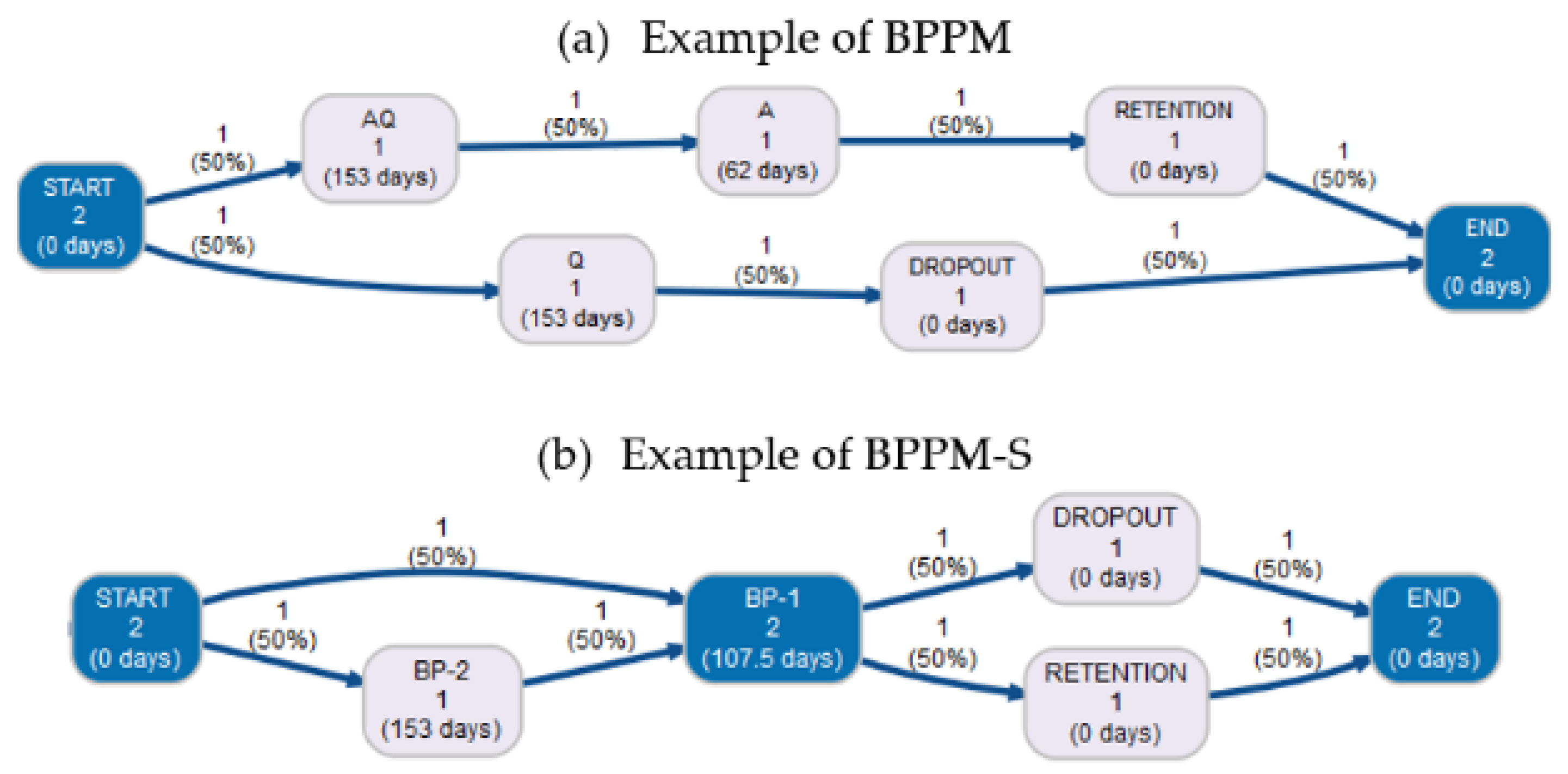
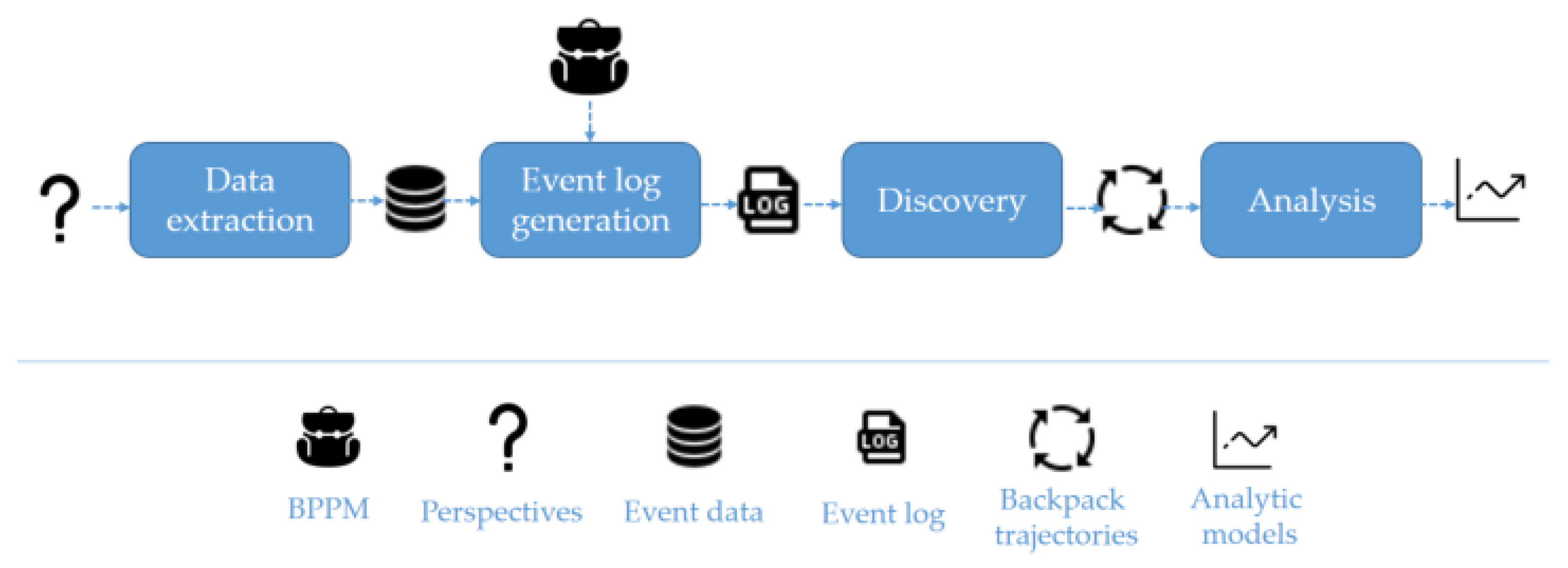

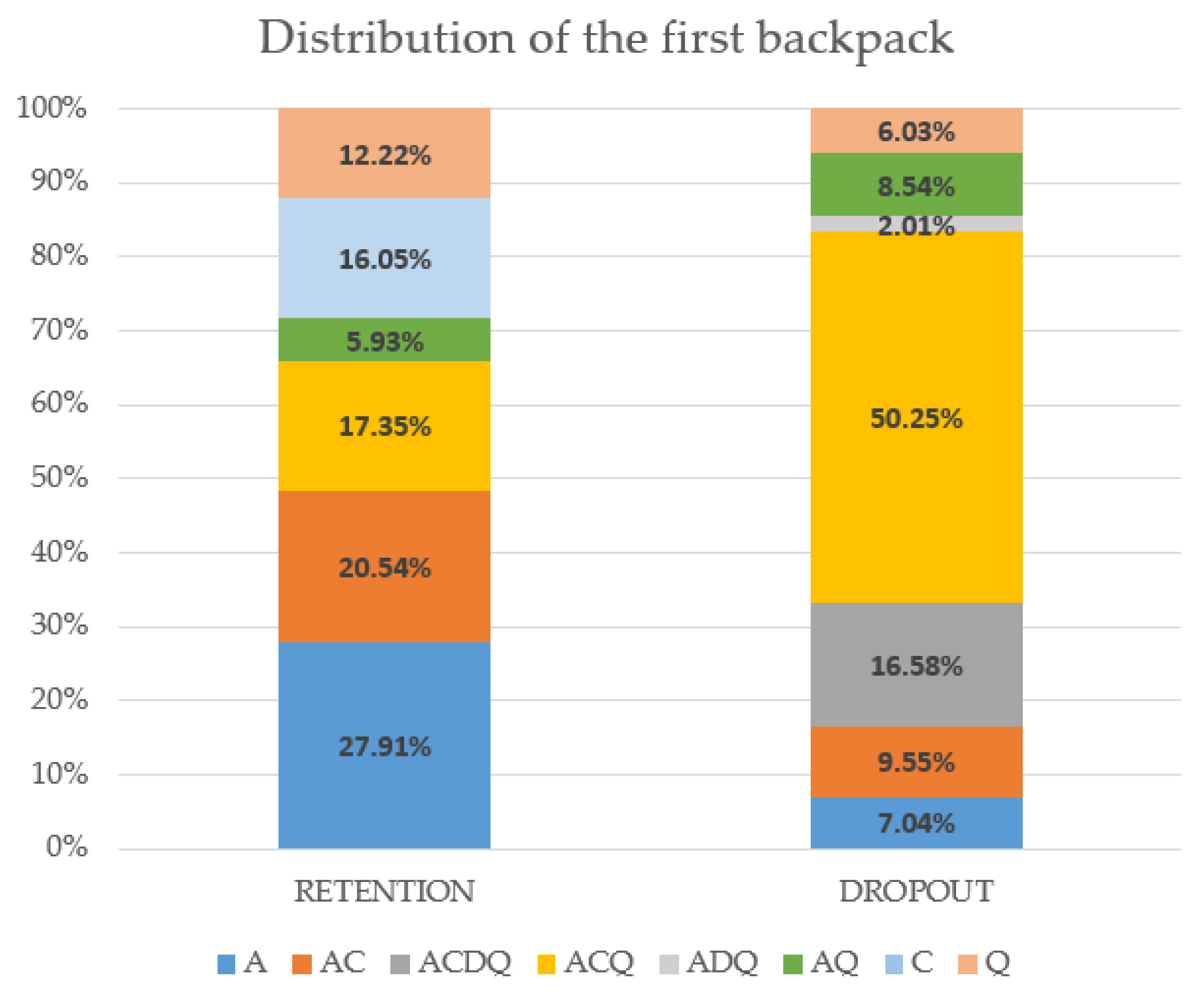
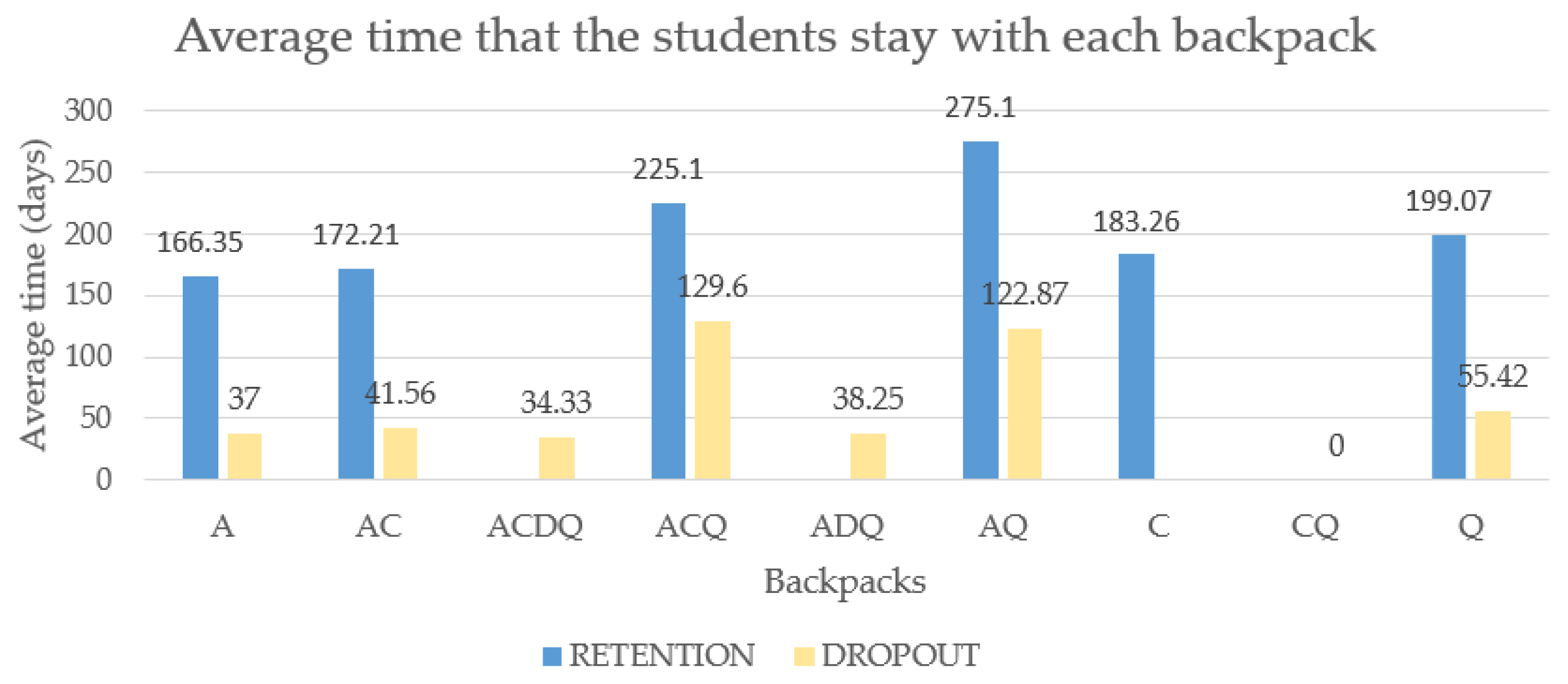
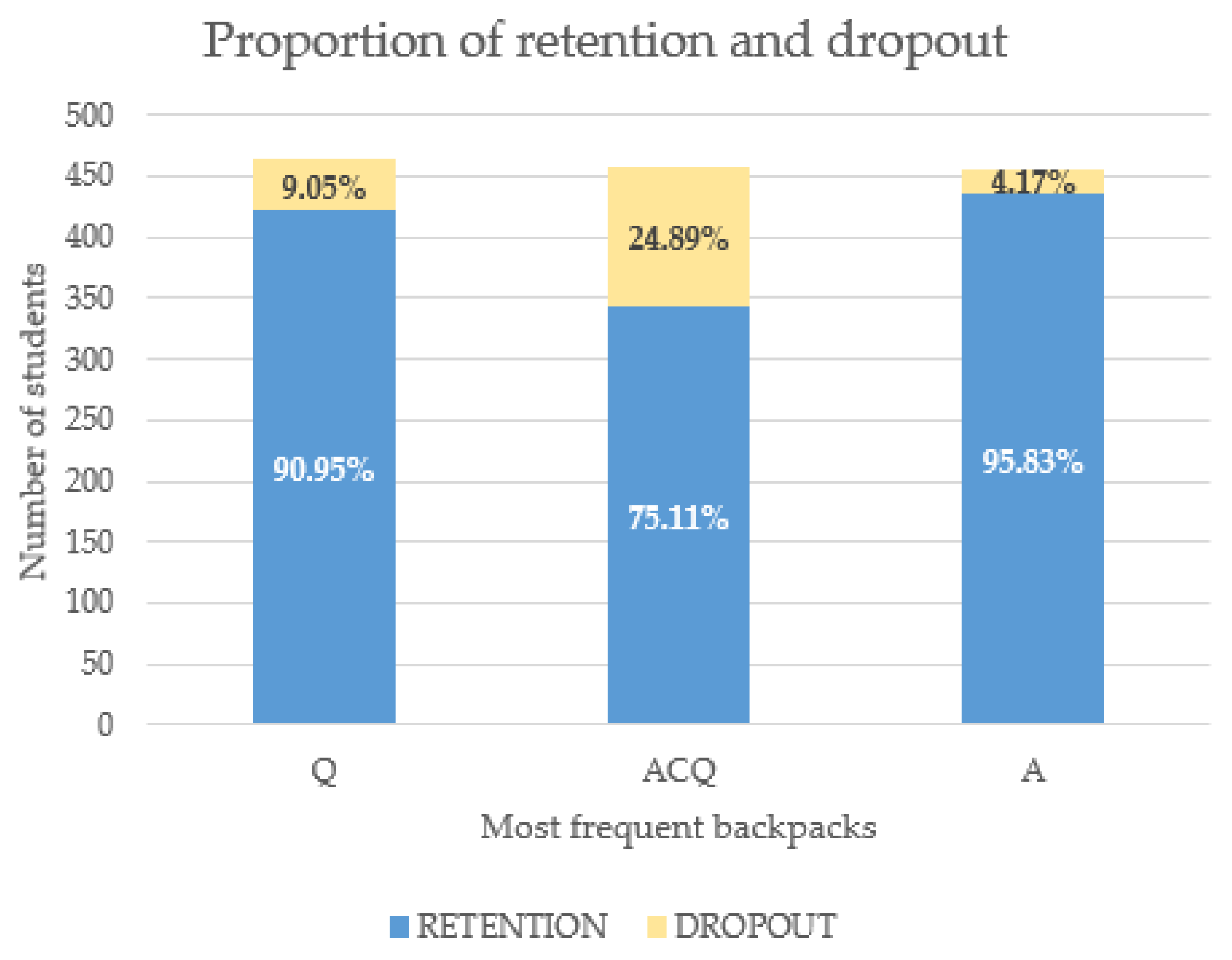
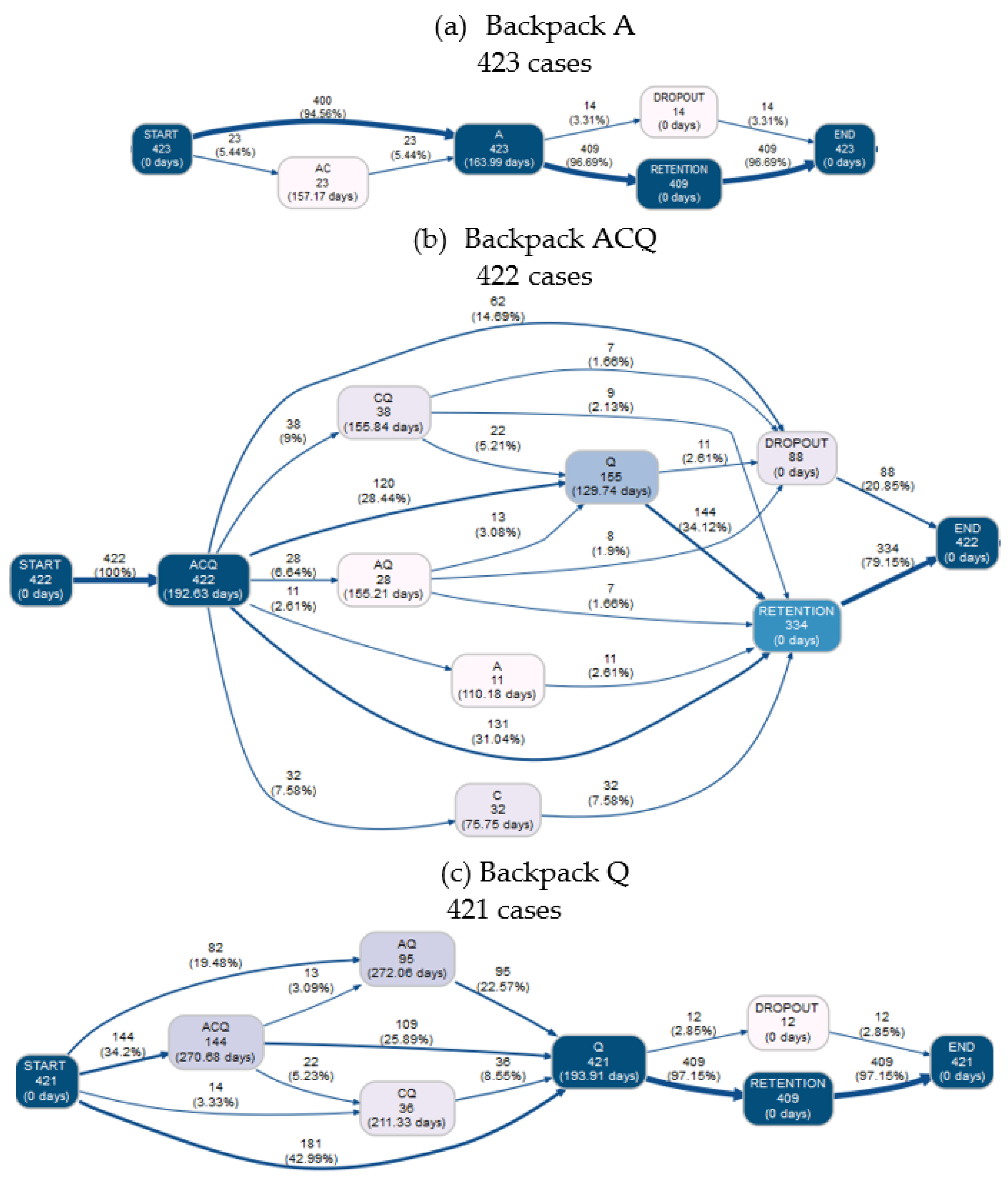
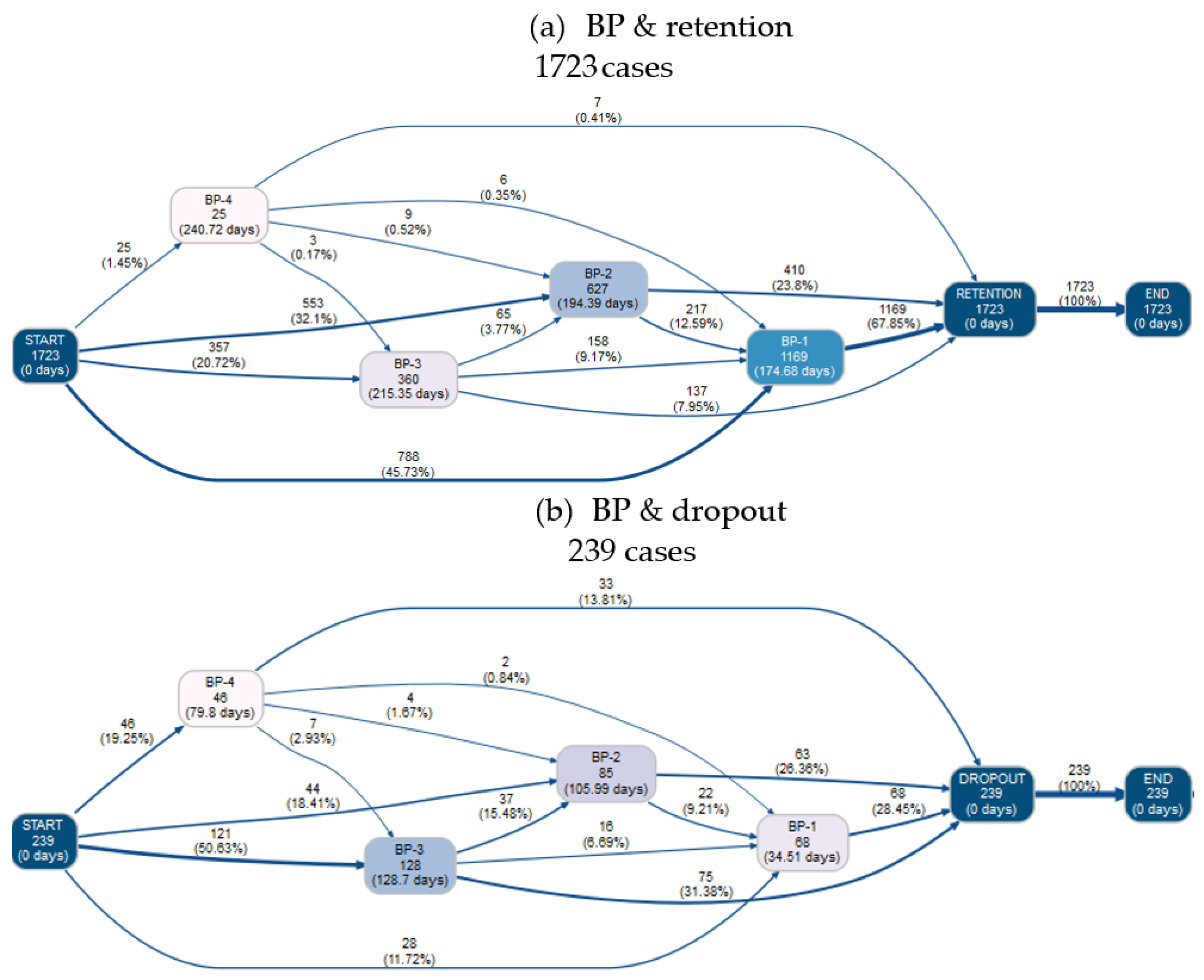
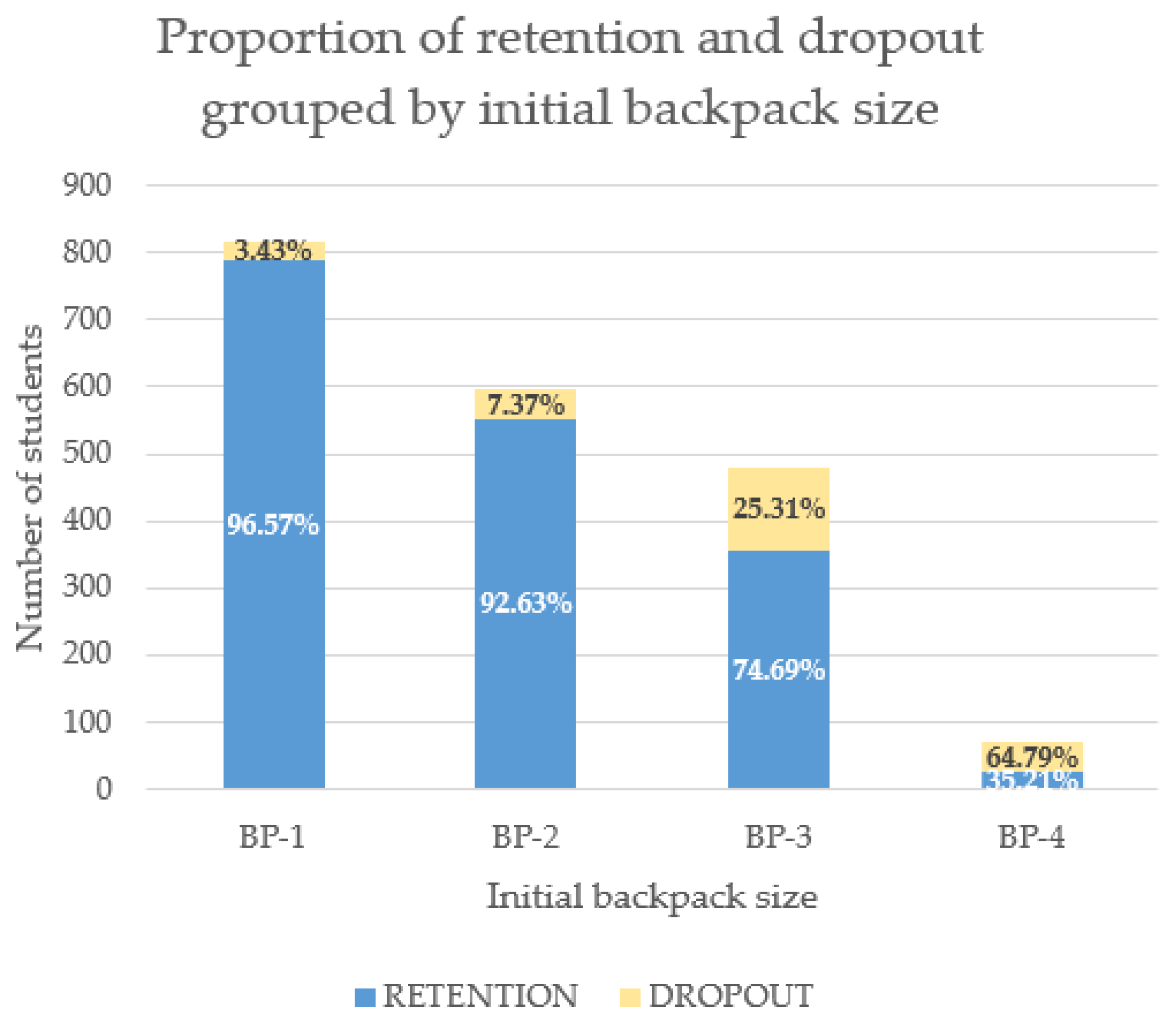

| Student ID | Backpack | Starting Date | Ending Date |
|---|---|---|---|
| 23 | AQ | 1 July 2013 | 1 December 2013 |
| 23 | A | 1 December 2013 | 1 February 2014 |
| 23 | RETENTION | 1 February 2014 | 1 February 2014 |
| 24 | Q | 1 July 2013 | 1 December 2013 |
| 24 | DROPOUT | 1 December 2013 | 1 December 2013 |
| Student ID (s) | Period (p) | Course (c) | Grade (g) | Ending Date (d) |
|---|---|---|---|---|
| 23 | 2013-1 | Algebra (A) | 2.0 | 1 July 2013 |
| 23 | 2013-1 | Chemistry (Q) | 3.5 | 1 July 2013 |
| 23 | 2013-1 | Calculus (C) | 4.5 | 1 July 2013 |
| 23 | 2013-1 | Innovation (D) | 5.5 | 1 July 2013 |
| 23 | 2013-2 | Algebra (A) | 3.4 | 1 December 2013 |
| 23 | 2013-2 | Chemistry (Q) | 5.0 | 1 December 2013 |
| 23 | 2013-3 | Algebra (A) | 6.5 | 1 February 2014 |
| 24 | 2013-1 | Algebra (A) | 5.5 | 1 July 2013 |
| 24 | 2013-1 | Chemistry (Q) | 3.5 | 1 July 2013 |
| 24 | 2013-1 | Calculus (C) | 4.5 | 1 July 2013 |
| 24 | 2013-1 | Innovation (D) | 6.0 | 1 July 2013 |
| 24 | 2013-2 | Chemistry (Q) | 3.8 | 1 December 2013 |
| Model | Perspective | Node Type | Transition Type | Filters | Figure |
|---|---|---|---|---|---|
| BPPM | (P1) Final event (DROPOUT or RETENTION) | Number of students | Number of students | Final state: RETENTION; DROPOUT Does not include initial state RETENTION More frequent variants: 80% | Figure 4 |
| average time | Number of students | Final state: RETENTION; DROPOUT Does not include initial state RETENTION More frequent variants: 80% | Figure 5 | ||
| (P2) Most frequent backpacks | Number of students; % students | Number of students | Does include state A; ACQ; Q Final state: RETENTION; DROPOUT | Figure 6 | |
| Number of students | Number of students; % students | Does include state A More frequent variants: 90% | Figure 7a | ||
| Number of students; average time | Number of students; % students | Does include state ACQ More frequent variants: 90% | Figure 7b | ||
| Number of students; average time | Number of students; % students | Does include state Q More frequent variants: 90% | Figure 7c | ||
| BPPM-S | (P3) Size of the backpack | Number of students; average time | Number of students; % students | Final state: RETENTIONDoes not include initial state RETENTION | Figure 8a |
| Number of students; average time | Number of students; % students | Final state: DROPOUT | Figure 8b | ||
| Number of students; % students | Number of students | Initial state: BP-1; BP-2; BP-3; BP-4Final state: RETENTION; DROPOUT | Figure 9 | ||
| Number of students; average time | Number of students; % students | Initial state: BP-1 Final state: DROPOUT | Figure 10a | ||
| Number of students; average time | Number of students; % students | Initial state: BP-2 Final state: DROPOUT | Figure 10b | ||
| Number of students; average time | Number of students; % students | Initial state: BP-3 Final state: DROPOUT | Figure 10c | ||
| Number of students; average time | Number of students; % students | Initial state: BP-4 Final state: DROPOUT | Figure 10d |
| Statistics | No BP | BP & Retention | BP & Dropout |
|---|---|---|---|
| Number of cases | 2504 | 1723 | 239 |
| Number of variants | 1 | 51 | 40 |
| Average number of BP events | 0 | 1.27 | 1.37 |
| Std. dev number of BP events | 0 | 0.52 | 0.62 |
| Mean time BP (days) | 0 | 237.74 | 131.80 |
| Std. dev time BP (days) | 0 | 183.71 | 178.48 |
Publisher’s Note: MDPI stays neutral with regard to jurisdictional claims in published maps and institutional affiliations. |
© 2021 by the authors. Licensee MDPI, Basel, Switzerland. This article is an open access article distributed under the terms and conditions of the Creative Commons Attribution (CC BY) license (https://creativecommons.org/licenses/by/4.0/).
Share and Cite
Salazar-Fernandez, J.P.; Munoz-Gama, J.; Maldonado-Mahauad, J.; Bustamante, D.; Sepúlveda, M. Backpack Process Model (BPPM): A Process Mining Approach for Curricular Analytics. Appl. Sci. 2021, 11, 4265. https://doi.org/10.3390/app11094265
Salazar-Fernandez JP, Munoz-Gama J, Maldonado-Mahauad J, Bustamante D, Sepúlveda M. Backpack Process Model (BPPM): A Process Mining Approach for Curricular Analytics. Applied Sciences. 2021; 11(9):4265. https://doi.org/10.3390/app11094265
Chicago/Turabian StyleSalazar-Fernandez, Juan Pablo, Jorge Munoz-Gama, Jorge Maldonado-Mahauad, Diego Bustamante, and Marcos Sepúlveda. 2021. "Backpack Process Model (BPPM): A Process Mining Approach for Curricular Analytics" Applied Sciences 11, no. 9: 4265. https://doi.org/10.3390/app11094265
APA StyleSalazar-Fernandez, J. P., Munoz-Gama, J., Maldonado-Mahauad, J., Bustamante, D., & Sepúlveda, M. (2021). Backpack Process Model (BPPM): A Process Mining Approach for Curricular Analytics. Applied Sciences, 11(9), 4265. https://doi.org/10.3390/app11094265









